I would like to express my sincere thanks to my Senpai Michael Reinhardt. He was kind enough to give me the okay to use material he uncovered during his research on the history of the Tenshinshō-Den Katori Shintō-ryū Heihō. Without his research, this article would have been much shorter. Thanks also to Anna Puntigam who was kind enough to read this article and provide me with helpful feedback.
Introduction
Our modern society still has to fight against sexist prejudices: many people still have the image that martial arts and combat sports are something for men, that women are perhaps too weak and it is not even possible for them to learn the martial arts and sometimes even the women themselves do not believe that they are accepted in the martial arts. Like a good friend of mine who is now passionately practicing kenjutsu. But in the beginning she was afraid she would not be allowed to learn the sword art she had chosen. Fortunately, she was wrong and can now proudly say that she is an Onna Bugeisha. This article is intended to dispel such prejudices and to show, through the history of Katori Shintō-ryū, the important role that women have often played in the martial arts.
The source of Shintō-ryū
Many people in the sphere of kobudo are well aware of the origin story of the Katori Shintō-ryū. Iizasa Choizai Ienao, a skilled warrior, is said to have retired one day, tired of war, to the grounds of the Katori Shrine in Chiba. There he is said to have devoted 100 days to extensive training in martial arts as well as meditation and prayer. Then one night Futsunushi no Mikoto, the deity of war worshipped at the Katori Shrine, appeared to him in a dream in the form of a boy sitting on a tree. In this vision, Futsunushi is said to have given the Mokuroku Heiho no Shinsho to Ienao. A scroll containing the deepest secrets of the art of war. Based on these events, the Katori Shintō-ryū is said to have been founded.
In the background of this legend, two goddesses should not go unmentioned. Amaterasu no Mikoto and Marishiten.

Amaterasu is the most important deity within Shintoism. She is the goddess of the sun and light. One of the most famous myths about her is how her brother Susanoo offended her so much that she retreated into a cave in dismay and imprisoned herself with a powerful stone. This plunged the world into darkness and all the gods had to come together to devise a ruse to lure Amaterasu out of her cave. Her grandson Ninigi became the ruler of Japan. Niningi fathered the first Japanese emperor, Jimmu, together with the daughter of the Dragon King, making Amaterasu the ancestress of the Japanese imperial house.
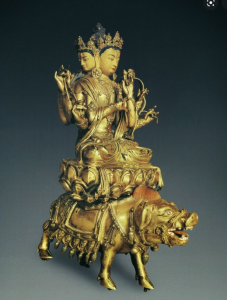
Marishiten is an ancient deity originally from pre-Hindu India. There she was known as the goddess Marici and was a goddess of war, dawn and patroness of warriors with the ability to make her worshippers invisible. She was often depicted with multiple arms, weapons and three faces. From dawn to dusk she is said to have ridden across the sky on wild boars. As a goddess, she continued to be worshipped in some cults within Buddhism, reaching Tibet and China. There she took the name Molizhitian. In China, she was even adopted as a goddess by some Taoist sects. Then, when esoteric Buddhism reached Japan, she came with it across the sea as a Marishiten and took a place in the Japanese spiritual world.
Futsunushi was one of Amaterasu’s generals. At her command, Futsunushi descended to earth with Takemikazuchi to drive out the last demons, monsters and hostile spirits and to pave the way for Ninigi’s reign. Marishitens role was to train both deities in the art of war. She was their teacher. Without these two great goddesses, the Katori Shinto-ryu would not exist today in the school’s mythology.
Yamato Nadeshiko – the ideal Japanese woman

The traditional Western as well as the Japanese image of women do not differ very much from each other. The woman has to stay at home, run the household, raise the children and obediently follow her husband.
And yet, for a true Yamato Nadeshiko [大和撫子], there is something in which she essentially differs from her Western counterpart: she also had to be strong and defend the house in the absence of the man! This fact is especially underlined by the naginata, a long sword lance. The naginata proved early on to be an extremely dangerous close combat weapon. However, as armies grew larger and larger, the spear soon took over as the favored weapon, replacing the naginata. Spears were much easier to use in formations and easier to handle. The naginata did not disappear from the battlefield overnight, of course, but it stayed at home more often, and sooner or later it ended up in the hands of samurai women. As a long weapon with some leverage, it served the women well and compensated for disadvantages in strength. A small and petite woman trained on the naginata could easily strike down a larger, stronger man.
Due to these circumstances, the tradition developed that samurai women were trained on the naginata. This circumstance led to the fact that the Naginata today in Japan is also considered a “women’s weapon”. Of course, there are also men who practice with the Naginata, but culturally Naginatado is considered something “for women”.
Woman of the Iizasa family
Nevertheless, the Katori Shintō-ryū was and is run purely patriarchal for generations and the typical western practioner knows not alot about the women of the Iizasa family.
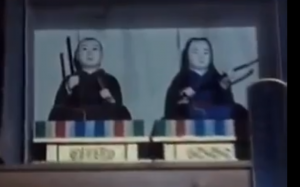
However, a few facts can be found here. Iizasa Choizai Ienao the founder of our school built his dojo near the Katori Shrine. There it stands to this day, the Hombu Dojo of the Katori Shintō-ryū. Of course, it has been rebuilt and renovated over the centuries. What is remarkable, however, is that Ienao’s wife is enshrined there with him in the dojo. Unfortunately, I do not know the name of his wife, but there together with him she is sitting next to him, holding a naginata in her hand. As the wife of a samurai that she was.
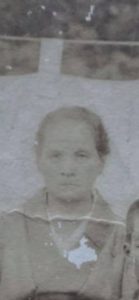
The second woman of the family that I would like to highlight is Iizasa Toi Sensei. In the official history of our school, the 18th Soke Iizasa Morisada died suddenly, without a male successor. For a time, under these conditions, the school was then led by the then Shihan with Yamaguchi Kumajiro as Kyoju, responsible for the technical transmission of the school. Later, a young man married into the Iizasa family and was adopted as a successor into the Iizasa family and installed as the 19th Soke Iizasa Kinjiro sensei, the father of our 20th Soke Iizasa Yasusada.
However, there are several documents from which it is clear that Morisada’s widow, Iizasa Toi sensei led the school in this difficult time after Morisada’s death as the 19th Soke and appears as such in a number of historical documents of that time. Among other things, she was responsible for the renovation of the Hombu dōjō and had collected money for it.
Olive Lloyd-Baker
Donn F. Draeger is a famous pioneer of Japanese martial arts. He was one of the most famous US-Americans who popularized Japanese martial arts in the West. In the 60’s he also began to learn Katori Shintō-ryū under a then young Otake Risuke and is generally considered to be the first Westerner to learn the school. However, this assumption is wrong!
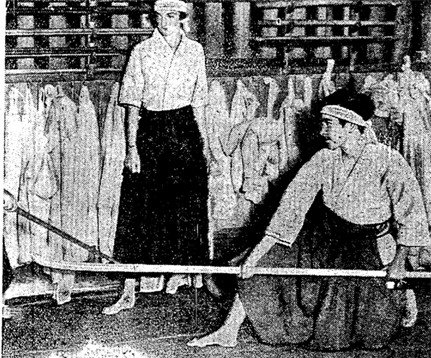
Olive Lloyd-Baker, born in 1902 in Gloucestershire England and her good friend Ms. Janes were the first two western students of Katori Shintō-ryū.
Ms. Lloyd-Baker came to Japan for a short period starting from mid-April 1927. There she stayed at the Imperial Hotel. Through the contact of Ms. Noguchi Utako, a member of the British Embassy, both women were introduced to Kaneko Masamitsu under whose guidance they learned Katori Shintō-ryū. They were instructed daily from 10:00 to 12:00, especially in the use of the naginata.
Itō Kikue
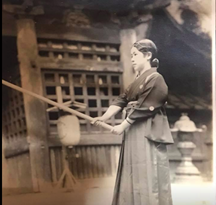
Itō Kikue Sensei was born on September 30, 1906 in Sawara, Chiba. The Itō family had held an important role as shrine guardians of the Katori shrine for generations. Itō Kikue sensei began her training in the Katori Shintō-ryū at a very young age under the supervision of Hongu Toranosuke sensei. Together with Sugino Yoshio Osensei she wrote on the Tenshin Shōden Katori Shintō-ryū Būdō Kyohan. She probably was responsible for the chapters concerning Naginata. She taught Katori Shintō-ryū Naginata in public schools during the 1940s and retired from the affairs of the ryūha after World War II to work as an elementary school teacher.
Conclusion
I hope I could show by several examples that while Katori Shintō-ryū, like many facets of society, is dominated by men, women nevertheless had an important place in it and the martial arts in general. The martial arts in Japan was never a place that was closed to women, but one that was traditionally quite open to them.
